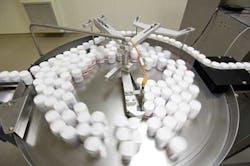Nutraceuticals: Comparing Automated Label Inspection Solutions
A major nutraceutical manufacturer wanted to address the risk of labeling errors in order to comply with regulations, and increase the speed and efficiency of its labeling operation. The marketing and sales teams also saw this as an opportunity to promote 100 percent quality control using the latest technology.
The company established requirements and goals before soliciting project proposals. The new system had to:
• Confirm label and carton identification (human readable and/or barcode)
so that the label matches the package content.
• Confirm lot number identification in case of a recall.
• Confirm expiry date identification for the end-customer.
• Ensure proper label placement on the bottle for brand image.
Line efficiency goals included 75 percent decrease in rework related to labeling error, 20 percent increase in the speed of the labeler and an increase in overall quality consistency.
DIY vs. system integration
When proposals came in, the project manager was surprised by the price difference between suppliers. Proposal review showed that the lowest price was a do-it-yourself solution that only included an off-the-shelf camera with integrated processing, while the highest priced solution delivered complete system integration.
PHARMACEUTICAL TRACK-AND-TRACE: Read this feature on how process and packaging functions interact with e-pedigree laws.
The off-the-shelf camera kit included a camera in an industrial casing with integrated lighting, software to be installed on a personal computer (PC) to configure the inspections, and a programming manual and free training at monthly seminar.
The turnkey proposal, on the other hand, provided by a dedicated solution provider for the company’s packaging line, included the following items:
• Project review and specification with the customer.
• Mechanical design and manufacturing of all brackets and adjustments.
• Ejection station with encoder, mechanical actuator, confirmation sensors and accumulation table.
• Product tracking, including all sensors and brackets.
• Camera with adapted lighting, which included all cables and enclosures.
• A central PC control station for the operator interface and visual display of defects and alarms.
• On-site integration and training.
• Field support by experts that are packaging-knowledgeable and PMMI-certified.
Having experienced the problems of internally developed control systems, the management team felt the choice was obvious: The maintenance department was there to run the operation, not spend its time developing new technologies. So the company chose the turnkey solution from Optel Vision (www.optelvision.com), Quebec City, Quebec, Canada in order to ensure a fast and smooth integration process.
Installation of the 100 percent electronic inspection system on all packaging lines has been a success. Operators saw benefits after just one week of use. Line efficiency has increased 10 percent while providing increased quality via reduced rework and better machine setup.
June 2011, Related Feature – Monitoring Green Roof Runoff
To read feature article, visit http://www.automationworld.com/feature-8876
Optel Vision (www.optelvision.com)
Subscribe to Automation World's RSS Feeds for Columns & Departments
